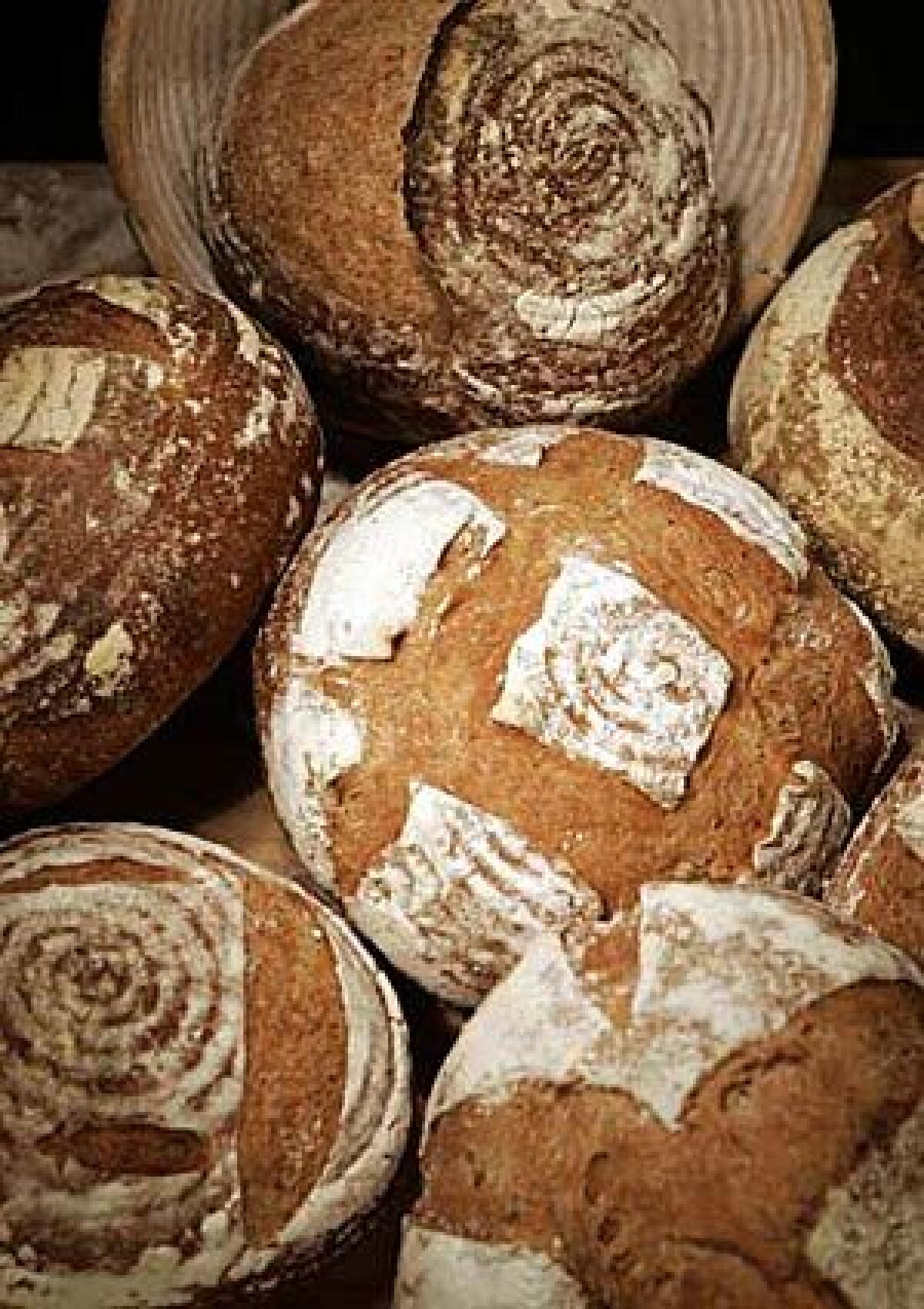Recipe: Whole wheat sourdough boules

- Share via
Total time: 1 hour, plus at least 4 1/2 hours rising time for the dough
Servings: Makes 2 small round loaves, or boules
Note: Adapted from a recipe in “King Arthur Flour Whole Grain Baking.” This recipe calls for “ripe” starter: The starter should have been “fed” 12 hours before you make the dough (see Whole wheat starter recipe). For a slightly more pronounced sour flavor, feed the starter up to 16 hours before making the dough. This recipe also calls for a baking stone and parchment paper. If possible, use a scale to measure out the ingredients for the most accurate measurements. See the blog at latimes.com/food for a no-knead method.
9 ounces (about 1 cup) “ripe” whole wheat starter
6 5/8 ounces (about 1 2/3 cup) whole wheat flour
11 1/4 ounces (about 2 2/3 cups) unbleached bread flour
12 ounces (about 1 1/2 cups) cool bottled or filtered water
2 1/2 teaspoons fine sea salt
1. In a large bowl, mix the starter, flours and water (use a spatula, a plastic dough scraper or your hands) until they’re well combined and the flour is thoroughly moistened. Cover the bowl lightly with plastic wrap and let it rest 20 minutes.
2. Stir in the salt, using a spatula or a dough scraper or your hands and knead the dough for 2 to 3 minutes to thoroughly incorporate the salt. The dough will be very sticky, but do not add flour. The easiest method is to cut and turn the dough inside the metal bowl with a dough scraper, which avoids getting either your counter or your hands overly messy. Cover the bowl again lightly with plastic wrap and let rise for 45 minutes.
3. Use the dough scraper to scrape the dough from the bowl onto a well-floured surface. With well-floured hands, gently pat the dough out into a rough rectangle large enough to fold in thirds (be careful not to flatten the dough while shaping as you want the dough to be light and airy in texture). Using either your hands or the dough scraper, gently fold the dough in thirds, as you would a business letter, brushing off excess flour with a pastry brush or your hands.
4. Fold the dough into thirds again (starting from the short end). If the dough is resistant to stretching, you may gently pull it so that it is large enough to fold into thirds; just be careful not to tear or flatten the dough. Return the folded dough to the bowl, cover loosely and let rise for another 45 minutes.
5. Remove the dough from the bowl and repeat the double folds (folding it in thirds twice), then put it back in the bowl, cover and let rise for another 45 minutes. Meanwhile, heavily flour two bannetons or cloth-lined proofing baskets. (If you don’t have any, you can make your own by lining medium baskets or colanders with linen tea towels and flouring them.)
6. Scrape the dough out onto a heavily-floured surface and divide it in half. For the “pre-shape,” pinch the edges of each piece of dough together into the center to form a rough round. Let the dough rest on the board, pinched side up, for 20 minutes loosely covered.
7. Shape each dough into a round by turning it over and gently tightening the surface: Pull the loaf toward you and roll it around, tucking the edges under very gently as you go, cupping your floured hands around the dough as you turn it. (Do not overwork this; it’s OK if the shape isn’t perfectly round.) Turn the boule upside down (pinched side up) and place it in one of the prepared bannetons or cloth-lined bowls, pinching the rough edges at the center together to seal the dough. Cover lightly with plastic and let rise until doubled, generally 2 1/2 to 4 hours. (Alternatively, after 1 hour you can place them in the refrigerator, tightly covered with plastic wrap, overnight or up to 24 hours. Remove from the refrigerator about 3 hours before baking to let them come to room temperature.)
8. At least 45 minutes before you’re ready to bake, place a baking stone in the lower third of your oven and heat the oven to 450 degrees. Place an old cake pan or, even better, a cast-iron pan, in the bottom of your oven. Place a small pan of water on the stove and bring to a boil (you will need 1 cup of boiling water when the boules first go in the oven).
9. When the dough is ready to bake and the oven is hot, turn the boules out of the bannetons or proofing baskets onto a piece of parchment paper. Slash the boules with a straight razor or serrated knife: Holding the blade at a 45-degree angle, make one deep cut -- about 4 inches long -- in an arc along the top of the boules.
10. Using a peel or an upside-down cookie tray, slide the parchment paper with the boules onto the baking stone. Using oven mitts and being very careful, quickly pour about a cup of hot water into the pan at the bottom of the oven. (There should be a lot of steam, so you may need to stand back.) Close the door and let the bread bake for 15 minutes. Resist the urge to open the door.
11. After 15 minutes, turn the oven down to 425 degrees. After 10 minutes at 425 degrees, rotate the loaves for even browning, which you should be able to do by pulling the parchment paper around. (The paper will get very dark, but it will not burn; if you prefer, you can remove it.)
12. Bake the boules until they are a dark golden brown in color and an instant-read thermometer inserted into the bread reads 210 degrees, 10 to 20 additional minutes. Using a peel or your oven-mitted hands, remove the boules from the oven. Let the bread cool on a rack to room temperature. Although it will be very difficult, resist the urge to slice the bread while it’s hot. Store the bread in a loosely closed plastic or paper bag at room temperature for up to 4 days; alternatively, the bread can be frozen, tightly wrapped, for up to 3 months. Do not refrigerate the bread to store (this will cause it to go stale).
Each serving: 107 calories; 4 grams protein; 23 grams carbohydrates; 2 grams fiber; 0 fat; 0 cholesterol; 289 mg. sodium.
More to Read
Sign up for The Wild
We’ll help you find the best places to hike, bike and run, as well as the perfect silent spots for meditation and yoga.
You may occasionally receive promotional content from the Los Angeles Times.










